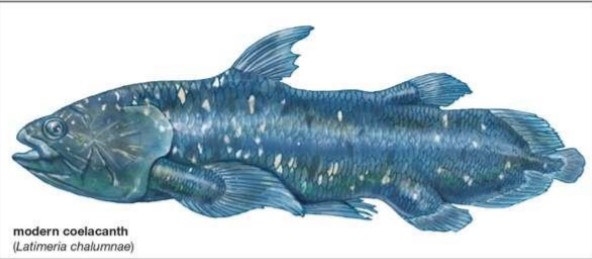INTRODUCTION
Crossopterygian, (subclass Crossopterygii), any member of a group of primitive, lobe-finned, bony fishes believed to have given rise to the amphibians and all other land vertebrates.
One major trait of the subclass is the division of the skull into an anterior, or ethmosphenoidal, unit and a posterior, or oto-occipital, unit. These units are remnants of two cartilaginous templates found in the embryonic cranium. A strong joint unites the two regions at each side. The base of the skull and the vertebral column are incompletely ossified, allow the persistence, to various degrees, of the initial skeletal axis, or notochord.
The subclass is made up of three orders: Rhipidistia, Actinistia, and Struniiformes. After being widely distributed around the world in the Devonian to Permian periods (416–251 million years ago), the crossopterygians underwent a rapid decline and then almost became extinct after the end of the Triassic Period (about 200 million years ago)

The Rhipidistia, predatory fishes of the Paleozoic, were ancestral to the terrestrial vertebrates and lived predominantly in fresh water. Rhipidistians probably had two respiratory apparatuses, a branchial (gill) system for aquatic respiration and a pulmonary (lung) system for air breathing.
To facilitate air breathing, the nasal cavities were provided with posterior nares (nostrils) homologous with the primary choanae (internal openings to the pharynx) of more-advanced vertebrates. The skeletal structure of the paired fins shows an internal skeleton with elements corresponding to some of the arm and leg bones of land-dwelling vertebrates.
This type of limb foreshadows locomotion both on solid ground and in the water. Thus, in the history of vertebrate evolution, the rhipidistians are credited with having made the great transition in anatomy and physiology involved in the emergence from water and resulting in the evolution of the amphibians.

STRUCTURE OF CROSSOPTERYGII
- The most striking characteristics are those of the head.
- The brain exhibits relatively little outward differentiation and has an extremely small volume with respect to the cranial capacity. (The brain accounts for less than 1.5 percent of the available space within the skull.)
- In addition, the forebrain shows considerable displacement relative to the floor of the skull.
- The snout contains a special sensory organ, the rostral organ, which is lined with electroreceptive cells.
- Fibrous connective tissues as well as a pair of powerful longitudinal muscles, the subcranial muscles that serve to close the intracranial joint, are attached at the intracranial articulation.
- The heart of the Latimeria is very primitive and exhibits almost perfect bilateral symmetry (mirror-image form).
- It lies within a substantial pericardial cavity that retains the primitive continuity with the peritoneal (abdominal) cavity.
- There is a series of small valves near the exit from the heart, and several small contractile organs attached to the branchial arteries apparently fulfill the necessary function of assisting the propulsion of blood.
- An enormous cylinder of adipose (fat) tissue, aligned with a short median diverticulum (a blind pouch) of the ventral wall of the esophagus, lies above the abdominal organs. It apparently is a result of the degeneration of a lung apparatus. The extraordinary size of this cylinder is related to a displacement of the kidneys that undoubtedly occurs in the course of development, these organs occupying an unusual ventral position, posterior to the anus.
- The body is covered with large rough scales. The powerful tail fin has three lobes.
- The posterior end of the notochord extends into the middle lobe, which is by far the smallest.
- Two pairs of fins, the pectoral and the pelvic, are attached to their respective girdles.
- The base of each fin is made up of a fleshy stalk, and each stalk is supported by several successive segments of bone or cartilage that are homologous with the similar parts of the endoskeleton of the paired fins of the Rhipidistia.
- Median fins similarly formed grow from the posterior part of the body, the posterior dorsal (above) and anal (below) fins.
- Finally, there is an anterior dorsal fin which, in contrast to the foregoing, is of ray-finned (actinopterygial) type—that is, lacking the fleshy supportive stalk.
- Modern coelacanths reproduce by internal fertilization, and the mother gives birth to live young.
AFFINITIES OF CROSSOPTERYGII
Crossopterygii shows affinities with Dipnoi :- Click here to read
Discover more from ZOOLOGYTALKS
Subscribe to get the latest posts sent to your email.


Pingback: GENERAL ORGANISTION OF GNATHOSTOMATA | ZOOLOGYTALKS | 2021